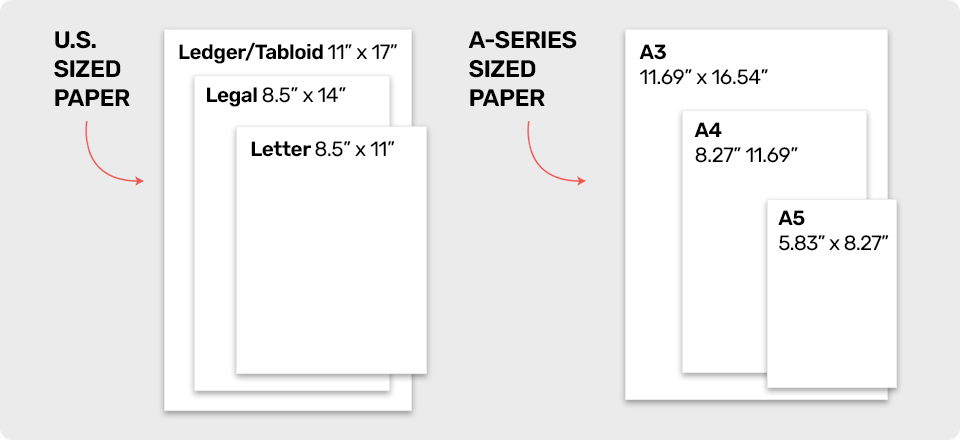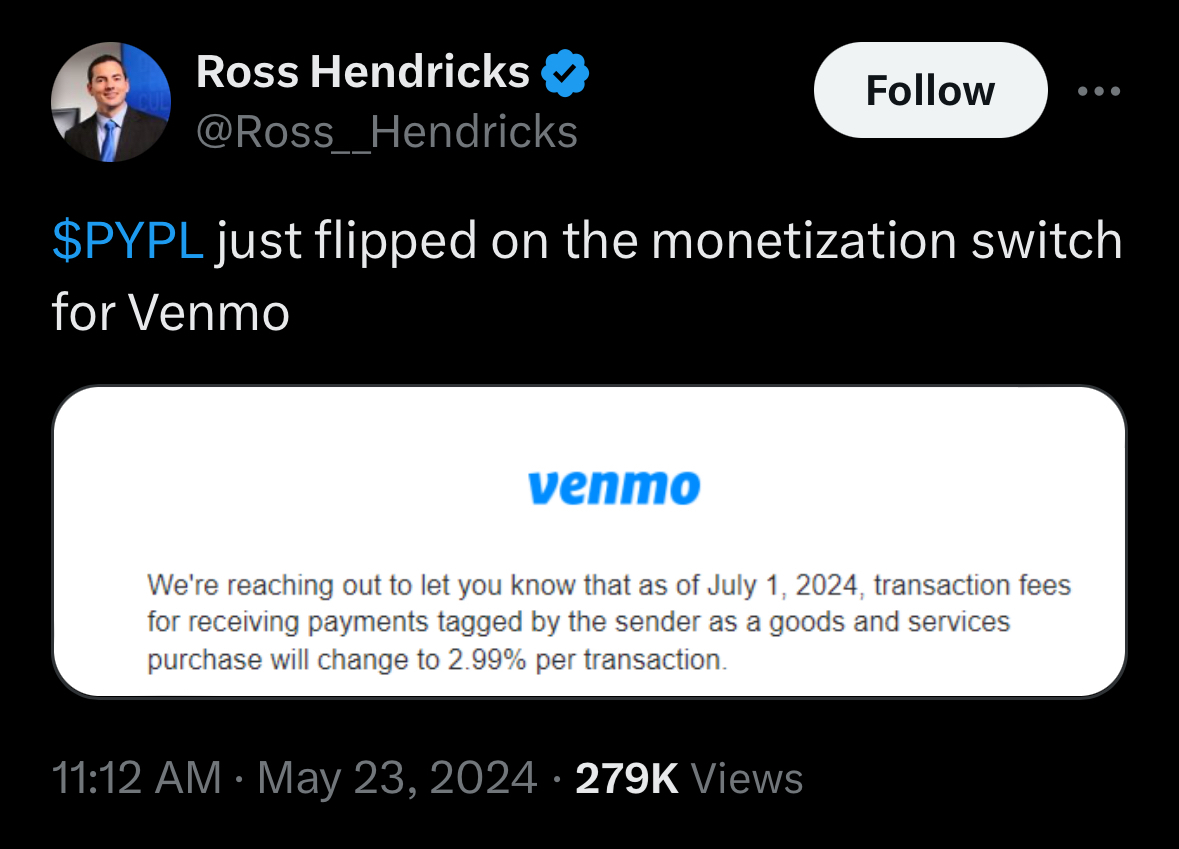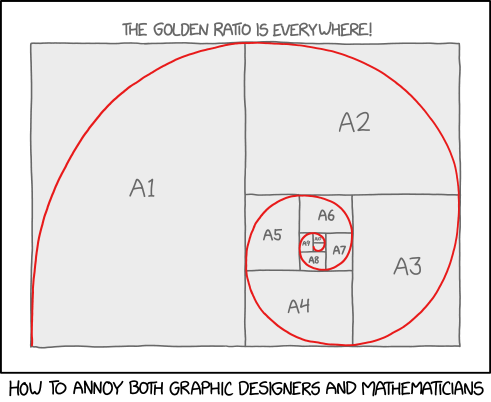alt-text
It blows our hivemind that the United States doesn’t use the ISO 216 paper size standard (A4, A5 and the gang).
Like, we consider ourselves worldly people and are aware of America’s little idiosyncrasies like mass incarceration, the widespread availability of assault weapons and not being able to transfer money via your banking app, but come on - look how absolutely great it is to be European:
The American mind cannot comprehend this diagram
[Diagram of paper sizes as listed below]
ISO 216 A series papers formats
AO
A1
A3
A5
A7
A6
Et.
A4
Instead, Americans prostrate themselves to bizarrely-named paper types of seemingly random size: Letter, Legal, Tabloid (Ledger) and all other types of sordid nonsense. We’re not even going to include a picture because this is a family-friendly finance blog.
Aside from the 1 to √2 ratio, the area of A0 paper is exactly 1m². People behind ISO 216 thought of everyting.
Which is awesome, because every number up halves the size. This, combined with the standard way that paper weights are given (e g. 80g/m2) allows you to easily calculate how much a piece of paper weights: 1 A4 80g/m2 weighs 5g (1/2^4 * 80g)
Now it makes even more sense!
People behind ISO 216 thought of everyting
how to make a good standard:
step 1: copy from DIN
Well, Germans are pretty anal about standards (thankfully) and they do them right, so why not copy them?
The world would be a better place if we copied good things more often.
Imagine all of Europe copied Dutch transportation-, German prostitution- and Portugese drug-policies
so why not copy them?
oh, I totally agree with you.
In fact standards are made to be copied. That’s like the entire point of them.
From their website: “We’re ISO, the International Organization for Standardization. We develop and publish International Standards.”
Sadly, ISO in recent decade started to do bullshit. They don’t pay for standard development, they don’t employ anyone for standard development, they collect membership fees from national standards organizations, require payment to download most standards and don’t allow to copy published standards. Also they retroactively paywalled a lot of standards.
Wait, the US genuinely doesn’t use A4 etc.?
We have trouble fitting all our freedom on your kooky, internationally-recognized sizes
Here’s a comparison using the most sensible units possible:

Ngl as a Canadian, I implicitly thought 8.5x11 was A4. Well that’s dumb, we should switch.
I’m British and you are not alone, worse still, I spent a year in the USA and never even noticed.
Also, I’m pretty sure A4 runs through an American printer just fine.
Most printers support a variety of paper sizes
They jam less
Letter paper (8.5" x 11" | 215.9mm x 279.4mm) is kinda sorta pretty close to A4 (8.27" x 11.69" | 210mm x 297mm) so without having the two next to each other, it can seem like A4 is just a funny piece of letter, and vice versa. But to answer the actual question, USA and Canada (and apparently the phillipines???) use the “North American Standard” which is a terrifying mess in comparison to the beauty that is the ISO standard.
Edit: typos
Philippines makes sense, being a former US colony
The US is a former British colony, but it doesn’t stop them from doing whatever the hell they want. Utter lunatics…
I’m sorry, I still haven’t forgiven them for the whole tea thing…
We wanted to make sure it was as salty as King George III.
America tried to modernise many British means of methods and standards. They used a metric currency long before Britain. That’s why they have a cent (1/100) rather than pennies and bobs and truppence.
They got ride of many terms for multiples of measurements that made the imperial system more similar to metric. Americans use ounces, but they don’t use pounds.
America also defines their us customary units using metric. There’s no longer an inch. There is a meter and from that an inch is defined as 24 millimeters. This is largely due to British, Canadian and American components for fighting wars not fitting together despite all using the same inch.
Had America modernised a little later they probably would have converted to metric earlier than Britain.
Tbf, I can see the use case for some “non-standard” sizes, like Legal, where having more height to the page without the extra width might be useful for readability of long documents.
…can’t think of an excuse for the rest, though.
That’s how it starts, you see the usefulness of one case, the next thing you know is you’re measuring distance in sheep and power in mice
power in mice
Hamsters, not mice. Get it right.
And always fractional, so, to convert from Farenheit to Celsius (inferior to kelvin, though), you take farenheit, add 57 mice, and divide by a hamburger.
As a European, I do appreciate Legal as a format.
It just happens slightly too often that an A4 is not long enough and the last bit, including the signature, goes to the next page.
I wish Legal was common here. Or perhaps we could get a Long A4 with a third extra height or so.
The Letter format should just be replaced by A4 though.
As a European, haven’t you heard about the existence of the B and C series of paper sizes? It may not be exactly what you have in mind, but B4 paper is 250 x 353 mm (9.8 x 13.9 in) and C4 paper is 229 x 324 mm (9 x 12.8 in). There’s also elongated A which is really long.
I hope you appreciate the irony of an American telling you about them.
There’s also scrolls, if Elongated A isn’t quite enough.
Tried these but my printer always gets caught on the wooden handle things 😜🤪
Time to update to a fax machine then!
https://www.possupply.com/other-pos-supplies-accessories/fax-paper-rolls-ribbons
I do miss the continuous form paper used with dot matrix printers.
It made banners easy, and I could make snakes out of the edges.
Burn the unbeliever!
As your links explain, C series is used for envelopes, while B and elongated A are special case that aren’t commonly used.
In any case, none of those series has an equivalent to American Letter.
The only paper that you will commonly find in European offices are A4 and (to a lesser extent) A3.
A big office printer might have 4 trays stocked with A4 and one tray with A3, for example.
I think Mexico too, or at least the paper name is “carta” and “oficio” which would translate to letter and legal (kinda)
Do you have a moment to talk about 8.5 x 11?
Make it quick there’s an important call coming in about my auto warranty
Just ask them to fax you
Their hole puncher has three holes and binders/folders have 3 rings as well
How many have yours got? More or fewer?
I have seen legal/letter sized clipboard with two rings, for the short end of the paper.
Either two or four. The two holes are kinda in the middle then if it’s four holes it’s those same two plus two more closer to the edge
And for 4, the spacing between them is the same as for the 2, leaving you 3 equal spaces.
And then there is Sweden…
YouTube content opportunity ❕
Comparison of US, EU, & Swedish hole punched paper. Which flips smoothest? Which is most tear resistant? Which tears most gracefully?
When have you ever seen a content gap on YouTube…
6-9 holes? Is that where Swedes keep their meatballs
Filofax If from UK. For these organisers and notebooks they produce, imho it actually makes sense to have several (equally spaced) holes.
Swedish Triohålning and especially the corresponding binders however, are mildly speaking impractical: It works starting from ISO A6 instead A7 and reading documents in a trio binder is a mess.
TIL
Also, if you fold a sheet in half, both sets of two match, so if you cut 4 hole punched A4’s in half, they’ll fit in two hole binders.
2, 4 or 23.
No, we mostly use Letter, Legal, etc. When you use photoshop to print, you would pick letter or legal usually.
https://goodcalculators.com/paper-size-conversion-calculator/
11x17 is incredibly common too. Usually it is oriented landscape and z folded to get a large diagram into a document. It’s kind of irritating that the most typical large format size is 24x36, which is a different aspect ratio than 11x17, for a variety of reasons. If you’re designing something you need to know what aspect ratio to design for. Most copiers can do 11x17, and if the standard large format size was 22x34 it would be exceedingly easy for most offices to produce good working copies of large documents. Best compromise I’ve seen is when people put a logo or header on the side that can be omitted when you switch aspect ratios.
Wait a second if the bank app can’t transfer money how do they do it? Just barter with guns? Are the bullets like coins?
We involve third parties to help spy on our transactions.

It’s OK, they charge us for the privilege.

Wtf?
Also are banks just dumb or what? Has it crossed their greedy minds that they also can charge to make transfers?
What’s pictured there is when people use Venmo to pay for something instead of just transferring money between friends. The fee is paid by the seller. Banks already do this for traditional sellers in the US which is why you’ll see signs asking for cash instead of cards.
And tax evasion. But I don’t care as long as the tamales are good.
Do Visa, Mastercard, etc, not charge transaction fees in Europe? The only place I’ve been where there’s no transaction fees paid by the vendor is China.
I owned a business in Europe. My bank charged me a pretty low monthly flat fee for card charges, so I would take cards for any amount.
I’m in Australia and it’s a mix. Some places add the surcharge to the bill and can use cc for as low as$1, some don’t and don’t accept payments that’s less than 2 people’s meals ( and also don’t accept split bills).
But it’s very very hard to find a place that’s cash only. It comes to mind empanadas, so I got a laugh at the other reply about tamales.
I mean charging the vendor a processing fee, not the vendor charging the customer for the credit card fee. That’s actually illegal in the US, though businesses can offer a cash discount, they can’t charge fees for using cards if they accept them. When I ran my business our card handler charged 3. something percent on every transaction with card, higher for credit than debit.
I don’t know.
We have a fee-free bank-to-bank transfer system that is based on pre-digital technology that takes 2-3 business days. We often call it “direct deposit” or automated clearing house (ACH). It’s often used for payroll and paying bills.
Now, we could probably make this payment system instantaneous relatively effortlessly (and thus useful for regular in-store purchases), but the banks lobby against this so they can continue to charge us fees and interest to over-use credit cards. (Interestingly enough, credit and debit cards all use direct deposit on the backend to actual transfer funds between parties).
This is all fine and dandy for most people because they simply can’t imagine doing things a more consumer-friendly way.
Your comment is all true, except - we CAN all imagine it, but as you pointed out, our unchecked hyper capitalism prevents it
We have a fee-free bank-to-bank transfer system that is based on pre-digital technology that takes 2-3 business days. We often call it “direct deposit” or automated clearing house (ACH).
Ah, right, kinda like SEPA Credit Transfer. You do need a persons IBAN which is a bit long, but their name is validated so you usually send it to the right person.
Now, we could probably make this payment system instantaneous relatively effortlessly
Ooh, cool, kinda like SEPA Instant Credit Transfer, which transfers money within ten seconds to bank accounts using the above mentioned number.
This is all fine and dandy for most people because they simply can’t imagine doing things a more consumer-friendly way
And that’s why, in the Netherlands, Tikkie took the country by storm. It is an app that allows you to use iDEAL (a web-based payment system, soon rolled out in Germany and Belgium as Vero) to send money to friends. Usually takes one pin and three taps to send it, and have it instantly appear on the account of the recipient.
Spain has Bizum, which I imagine is similar to Tikkie, where you go into your banking app, and instantly send money to a phone number, usually from your contact list, that is also in the bizum system, zero fees.
I imagine it has also something to do with safety? Like, if it was instantaneous, that means you can do damage instantaneously, or a hacker might have fewer hurdles to go through.
Venmo, Zelle, Cash app, etc.
My last 3 banks all had ACH transfers in-app, too, so idk what they’re smoking
And the ACH only takes three business days!
3 days? UK here, the other day I transferred money to my wife (different bank) while she was handing her card to the cashier at the supermarket. It took about 1 second.
Surely there’s some challenger bank letting you do modern stuff?
Hahaha! We don’t have fair competition in America, silly!
ACH transfer to a friend’s bank account?
I assume it’s ACH, I’m at work and my job includes doing ACH work so that just kinda typed out.
It has me put their routing and account number in, then took anywhere from 5 minutes to a day to clear, p sure that’s ACH
Wow awesome!
A day isn’t cool, but five minutes is pretty much acceptable.
I’m in Aus and our transfers are usually instant. However if you’re transferring a couple hundred bucks or more, and you haven’t made a transfer before to a person, it will hold it for a day. I think to give the customer time to call and say the transfer was fraudulent.
I pay monthly rent in Australia with that, couple thousands and no big deal
I don’t think it generally does them for person to business transfers, just person to person. But yeah it’s how most people pay their rent, whereas cheques still seem to be common in the States for rent.
I respect that!
Removed by mod
Like most things, it depends on which state you’re in.
i just assumed people used 3rd party services for ease of use or faster transactions, seems so wild that you’d not be able to send money using your bank to me
here it takes 1-2 business day for a free wire transfer from one bank account to another, and you can do it in your banking app or on the bank’s website. you just need to authenticate with your online pin code. you can also pay 1€ to get a <24h transfer
it’s honestly much better than using a third party service, since pretty much everyone has a bank account, and pays using a card tied to that account directly
Brasil enters the chat
No fees transfer takes seconds, as long as it’s not international. People use it for buying groceries, clothes or paying for whatever they buy in the middle of the street from other people who are not businesses. Confirmation of payment from receivers end is immediate with a push on your phone.
All sellers can produce a QR code including receiver address and price to be payed. All bank apps scan and pay seamlessly.
Quite similar to India’s UPI system
Russia enters the chat.
Same. It is done with National Payment System of Cards law, which people usually call “MIR cards”. It started as replacement system for visa and mastercard, but evolved into System of Fast Payments/Transactions.
You can use it in three ways: enter recepient’s card number, enter recepient’s phone number or use qr code.
In Canada we have Interact e-Transfer. Basically all the banks colluded to make a system that allows for instant money transfer between banks using email or phone number as the recipient identifier, along with options for comments and security questions.
I felt like this was a huge step up compared to all the hoops and third party apps I had to use in Europe.
huh, yeah, i heard of similar things in the US
here it seems to be worked out through legislation though, rather than private deals, but that means it’s much slower to get set in place
Idk what all this talk is about - we have wire transfers in the US. I don’t need a third party to do it either, it’s exactly as you’ve described, I can do one through the bank’s app or on their website, and it’s free. It’s not as common though since the information required is: Name of the recipient’s account exactly as it is, account #, routing #, and exact name of the bank tied to the routing #. You can save that info though to make it easier to transfer the next time around - it’s very useful for close family and friends.
EDIT: Turns out I have two different ways of transferring money. One is just moving money between accounts, can be at the same or a different financial institution, has the same functionality as a wire transfer, is free, and doesn’t rely on third party apps. A wire transfer is apparently done via some federal system and does require paying $20 or so, but I haven’t had to do a wire transfer in forever. I’m not sure why anyone would want to do a wire transfer.
and it’s free
This is very uncommon in the US. Most major banks (I’m not aware of any exceptions) charge a fee for each outgoing wire transfer, usually $25-$30. Bank of America, Wells Fargo, Chase, and PNC for just a few examples I’m aware of, plus every credit union that has local branches in my area. Some of those banks even add a second fee at the recipient’s side for incoming wire transfer.
They often encourage customers to rely on third party services like Zelle instead for small transfers to friends and family. Many banks’ sites/apps can also handle transfers between two accounts that both belong to the same bank for free too.
Looked into it some more - I can move money to an external account via the app at no cost, but a “wire transfer” needs to be performed in person or over the phone with my bank, and there is a $20 fee. Not sure what the difference is besides the name and how the banks are handling it, but it’s the same thing. I can send money to someone at the same or a different bank/credit union for free and without relying on third party apps. Will edit my comment.
huh, here you only need the other account’s IBAN
SEPA is not to take for granted.
Isn’t sepa the eu system?
Sorry but bank transfers are not 1st world exclusive, it’s common place in 3rd world as well.
I don’t doubt it. With SEPA you can transfer hassle-free to 36 countries and with low / no fees.
Actually, a lot of banking apps can be used to transfer money now, it’s just done through Zelle. We can also do a bank transfer using the routing and account number (at least with my banking app) but that I think takes longer.
They can. Idk about the availability for all banks but we have something called Zelle.
fun fact: the length to width ratio of ISO 216, √2:1, is the same ratio as the tritone in an equal tempered 12-tone musical scale. If you fold A4 paper in half, you get a piece of paper with the same length to width ratio as before; analogously, if you invert a tritone, you get another tritone.
As famously read from letter-sized sheets:

I know it should be a fun fact but I can’t quite grasp it.
But is it a diminished fifth or augmented fourth?
Ackchyually…
That is fun!
idk why the image says “european”, the standard is worldwide. only north america and parts of latin america don’t use it afaik.
Japan also has their own system.
Japanese use JIS but A size is the same with ISO so there’s no confusion here. For B size there’s slight difference in JIS and ISO, but as end user I hardly print anything other than A4 so haven’t encountered problems myself.
I know Brazil uses the A# format, dunno about other latin countries.
A Sharp?
Extra painful papercuts
no A-Hashtag you dummy
A-pound
AOctothorpe
nah that wpuld be A-£
Nah you mean A-lbs
That’s 12 A-Inch in imperial system isn’t it?
The annoying “letter” paper size is for some unknown reason what windows always sets as the paper size unless I change it to A4 manually. Naturally if I forget the printer won’t print. US paper sizing - annoying me on the other side of the Atlantic.
File I’m printing: A4 PDF
Default printer setting in Windows: A4
Default setting on printer itself: A4
Setting that gets chosen automatically in the print dialog: Letter
Is this why my printer has wierd size “letter”, that is not sized like letter?
Yeah, US software always defaults to their own non-compliant standards instead of looking at the location and determining the default that way.
That is why we in Europe and all the other parts of the world get these strange fuzzy prints where the text is almost unreadable, and is cut off on strange parts in the text.
This sounds like our bad, sorry.
My country (not USA) uses American paper. I hate it.
Do Euro printers say PC LOAD A4?
I think they probably do.
I want to only briefly defend the NA system in terms of naming. I get it, I worked in printing for decades, I know how shitty it all can be. But Letter and Tabloid communicate well for something that is otherwise all the fault of press guys.
Well, it’s 2024, so they mostly say things like “out of A4 paper - load A4 paper in tray number 3”. But yeah, they used to.
Interesting, no photos of that message come up.
TBF, I only remember messages about “out of paper” or “all trays are empty”. Why specify paper size if the printer accepts different ones, anyway?
I’m thinking it lets a tray run out, then you ask it to print on a certain size of paper, and in response it asks for more of that size paper. Then you know which exactly it’s out of. Good for an office too where you don’t know who printed what.
Well, one still could do it like how many countries transitioned to the metric system: slap the traditional names onto things that are actually now defined by the metric system, like how China’s catty, about 0.60478… kg, became 0.5kg. Just slap “Letter” onto A4.
That’s going to make some driver developers very upset. And sensors in printer cartridges that can sense both A4 and Letter.
I say we just balls the whole thing. Screen or pencils.
For technical purposes that need to handle both you can just disambiguate it with “Letter (new)” and “Letter (work or school)”
Is that a subtle dig at Microsoft and their 5 billion different versions of Teams?
You really think people are too dumb to remember 2 letter codes that are literally printed on everything? Come on man :D
yes, thats why i always was confused when i heared people online talk about pc load letter.
i kinda assumed it was just an odd way to refer to paper that some manufacturers used
It’s a beautiful standard that works wonderfully until you have to deal with any actual measurements. 210 x 297 mm - so easy to remember and divide.
Letter is 215.9mm x 279.4mm lmao
Good thing Americans don’t use metric, that sure would be an awkward size.
No it’s 8.5 by 11.
See? Easy. Also you really have to try to get your hands on something that’s a different size. 99 percent of printer paper is Letter.
99 percent of printer paper is Letter.
Maybe in America. Over here you won’t be able to find Letter it’s all A4.
Well yeah. The point is most people never have to interact with any other size.
Pretty much the same is true everywhere else though. A4 is just extremely common. All documents are printed in A4.
But if you want another size for a sign, blueprint or maybe a postage sticker it’s easy to get another size. If you want A5 just print the same thing twice on an A4 and cut it in half after or cut the paper in half first and then print on it.
If you want A3 you will obviously need a bigger printer (or you just tape two A4 together if it doesn’t need to look good.)
I think I screwed up the assignment somewhere? For some reason the tape sticks to my letter sheet but not my A4 sheet and my construction paper crayon drawing is still too big for them to create a proper border?
8.5" is not any easier to divide than 297mm. Try dividing 8.5" by 8. What is that? 12 pebbles and 14 glibglobs each?
1" and a sixteenth.
Ah yes - a system that uses both fractions and decimals!
Don’t bother, it seems the metric are allergic to fractions that aren’t irrational.
^/s
It’s 1.06 Which is close enough to just do 1 inch cuts. Super easy. No possible better way to do it.
deleted by creator
I think we’re on different levels. I’m solely here to make fun of both groups thinking they’re superior.
deleted by creator
Why does this satire thing have to be so hard?
The only time I ever encountered letter was when I bought the D&D starter set.
I was confused as to why the paper had this weird size. Then I remember it being a game made in the US.
Well that solves it if WOTC used it then we need to get rid of it. Burn it in a fire. And we’ll need a new standard now. We could use the ISO standard but Western Union just handed me a thousand bucks to base it off telegram cards. Oh well.
Excuse me, I believe you meant to say:
215 57/64mm x 279 38/96 mm
i mean, i’ve never needed to divide the size of a standard sheet of paper - if i need a smaller variant, i can just fold it in half and cut it. when working with paper, it’s pretty easy to do physical math, and you rarerly need something that’s perfect down to the millimetre
regarding the size- it’s just something you learn through life. school supplies lists typically specify the size of notebooks and paper you need to buy in centimetres, so year over year, you quickly learn that A4 is 22:29.7, and the slightly bigger standard notebooks are 24:32
so year over year, you quickly learn that A4 is 22:29.7, and the slightly bigger standard notebooks are 24:32
Pretty sure you just justified Americans using Fahrenheit ;)
how so?
Arbitrary numbers become habit
i mean, celsius has arbitrary numbers too - human is 37°c, ambiant is 17°c, cooking is 180°c, etc.
You forgot the /s
A4 is rectangle with 1:sqrt(2) aspect ratio and 1/16 m^2 area.
1/16? That doesn’t seem very metric. They should have made it a tenth like everything else metric. That would be an easy system.
^/s
I don’t disagree! And in the interest of fairness I feel compelled to include an obligatory xkcd:
300-3 isn’t that hard to remember. also i don’t know why you would need to divide it. they’re both divisible by 3 if that helps.
As a math nerd, I appreciate the fractaline nature of your paper.
But as an american, what is the practical advantage?? The sizes are so far apart, and you dont get papers with different ratios? Like for example Letter and Legal are both 8.5 inches wide, can be used in any standard cheap household printer, legal is just longer so you can fit more stuff on the page. Letter paper folds into thirds to fit snuggly in an envelope and legal folds into fourths. Other paper sizes are so niche and rarely used why does it matter if theyre a perfect mathematical ratio or not?
The advantage is folding.
When folded at the middle it becomes the next size.
So if you have an A4 paper but don’t have the proper C4 envelope, you can fold the paper in half and put it in a C5 envelope. This is standard.
Let’s then imagine that you don’t have a C5 envelope either, but only have the remaining Christmas card envelopes, which are C6. So you just fold your paper one more time at the middle and it’ll fit again.
Also, the area of A0 is 1 square meter. You probably don’t nornally have an A0 paper around, but that doesn’t matter, because you can take 8 pieces of A3 or 16 pieces of A4 papers, tape them together and it’ll be A0.
Now it isn’t actually a square meter. It’s the same area, but it’s not square. No, the length and width makes the golden fucking ratio. This might be irrelevant for a legal document, but it’s pretty neat if you want to make a nice drawing.
Paper come in reams. Reams come in boxes. Boxes come on pallets. The paper boxes fit perfectly on a pallet in both length and width, so the layers of boxes can be placed either way in an interlocked pattern. This is mostly a box design thing though. American paper also fit on American pallets, but without the connection through the sizes, you cannot make a pallet with mixed sizes and expect it to fit.
Forgot to add: the real beauty isn’t the paper size. It’s simply having a standard. Cans and bottles and lots of stuff follow similar metric standards. It’s possible to mix everything and still make it fit snuggly on a euro pallet.
Isn’t the ratio of length and width of A-papers square root of 2 and not the golden ratio?

Correct. A piece of paper with the golden (aspect) ratio would have the property that if you remove the large square (with side length equal to the shortest side of the rectangle) then the remaining rectangle has the same (golden) aspect ratio.
The ISO216 ratio of 1:sqrt(2) has the property that if you cut the paper in half then both halves have the same aspect ratio as the original larger piece.
People tend to confuse these two properties as they both involve the remaining rectangle having the same aspect ratio as the original piece, but the process to bisect the sheet is different.
But that’s not something i have ever actually needed.
Well, more efficient packaging and shipping is a pretty good goal in general. Although what’s better is just…not having to ship pallets of paper around, it’s 20 fucking 24.
Limitless paper in a paperless world
You say that, but you pay a premium for these things to be generally less efficient. Why waste?
Scalability. You can design something in A3/A4 and if you want the page in a smaller, common format, you can print it as A4/A5. This is especially handy for designing flyers, or scaling bigger stuff (like schematics, which are usually drawn on A1/A2) down to print it on household printers.
It’s also quite convenient that pretty much anyone has a common understading of what A3/A4/A5/A6 is, when talking about areas in real life.
Also, if you need A5 put only have A4 paper, you can cut it or even split it without scissors. That usually even gets better results, because splitting a piece of paper in two by folding is easier to do precisely that to do it whith scissors.
Making a page longer just to “fit more stuff on it” isnwt really such a great boon, since you always need a cut-off somewhere.
A4 can be folded into thirds as well and smaller envelopes are perfect for A6.
yeah, this is a great thing!
i usually make class notes recap on A4 pages, and can then print 2 A5-sized pages side by side on a single standard A4 paper, no need to rework the formatting. messing with the printer options, you can pretty easily get it to do a small booklet off of your standard A4 word document, just need to staple it together!
It’s also quite convenient that pretty much anyone has a common understading of what A3/A4/A5/A6 is, when talking about areas in real life.
We know “the size of a sheet of printer paper” and also that size when “folded hot dog” or “folded hamburger”.
Y’all can’t fold ‘em fish ‘n’ chips, ever heard any food terms used to refer to length/wide folding?
Commercial printers will print most everything on A0 paper, but since all metric paper is doubling or halving sizes with respect to each other, they can tile a bunch of print jobs into the same A0 paper and then cut them apart, saving machine time by turning a bunch of small jobs into one big job.
US printers also do this, just using larger ANSI sizes instead of larger A sizes. Or they just use rolls.
But US paper sizes don’t tile nearly as well as metric paper sizes do, is the point
They do tile, they just don’t share an aspect ratio. Two letter sheets make a tabloid or ledger sheet (depending on grain direction of the paper), and two tabloid sheets fit on a broadsheet, which generally comes in rolls so there’s a bit of trim because the size comes from actually physically dealing with paper, which is why they’re also the names of the newspapers that were printed on them. Like, it doesn’t go down from letter like ISO a sizes do, but it generally works well enough.
Just use multiple pages if needed?
Who needs all their words on a single huge page like some sort of scroll?
It takes less paper to print 1 page of legal if that’s what your text fits on than it does 2 pages of normal paper if said text doesn’t take up all of the second piece of paper.
When you’re printing large documents (10 or more pages let’s say) that starts to be significant savings in thickness of a stack, too.
It’s not one huge page, it’s an extra 2 inches, or ~25% longer
Wait… You can’t transfer money with a banking App???
Not really sure about that one, I’ve been able to transfer money with my banks app for more than a decade. Not all US banks are created equal.
Not all US banks are created equal
I think that’s the issue. Also how common direct deposit for paycheques in the US? I hear it’s rare but in Canada, it’s the norm and all our banks here can do e-transfers.
I’ve had direct deposit for every job since around 2004, before that it was a paper check on payday. Really I signed up for direct deposit after my manager gave me a hard time when I came in to pick up my check on a day I called out sick.
It’s relatively common, unless you work for a typical cash pay job (usually labor jobs, like construction)
I’ve had direct deposit at every job I’ve worked for over a decade. Before then, I only had one job that didn’t offer it, though I had friends with jobs that did have direct deposit. Very common to have it these days. Some jobs can even get you direct deposit for the amount you worked that very same day, so I’d work 8 hours and by the time I get home, I’d have my pay from that day, and it’s like that everyday.
Source: US citizen
Yes. I can transfer money to someone just by knowing their phone number. I can do it on a Sunday afternoon and they get the money instantly. I haven’t used cash for more than a decade now. Haven’t used a card for at least 5 years.
I’ve been able to transfer money through my banking app for a while without issue. Not sure where that came from in the post, cause it’s not true lol.
Zelle is a thing with my banking app.
My sister has a credit union bank account and her app has it. I have PNC.
America got someone triggered over paper.
Shooting ourselves in the face to own the mets
Let’s not even start with the metric system (used everywhere) and the imperial system (used in the usa and some african countries).
Don’t let the UK get away with their bs as well, they use a mix of metric and imperial. Imo that even worse bc at least america is consistent with their bs measuring system

Most annoying is cars. We buy fuel in litres but measure our cars efficiency in miles per gallon, meaning I either have to calculate how many gallons I put in my car or how many kilometres I’ve driven to work out if I’m being more or less economical.
You’ve got to be kidding. How can that make any sort of sense?
And Canada. I hate that map of the US and Burma. The US uses metric as it is part of customary units anyway. I also wish metric was base 12 or 16.
OMG! This! I wish our numbering system was base 12 so much! As a species, we’re ready to evolve
I never gave any thought to this. Why is base 12 better?
Because it’s divisible by 2, 3, 4 and 6, which makes it easier to do fractional values. 10 is only divisible by 2 and 5.
Americans aren’t consistent either. 2 liter and similar bottles (and it’s not even the same bottle, like they aren’t reusing molds or anything, it’s just an American 2 liter bottle). Sharp edges and points like on mechanical pencils are in millimeters. So are many nuts and bolts. Stuff like electricity and power are measured in metric units. Generally electronics/computer parts are in metric, the main exception that comes to mind is screen size, which even the rest of the world does in inches (LIKE WTF!?!).
There’s plenty of examples of metric units in the daily life of an American.
According to wikipedia: “Some imperial measurements remain in limited use in Malaysia, the Philippines, Sri Lanka and South Africa.” - so, not even “some”, just one African country, and limited use.
Uh, I’ve never used inches, nor know anyone who does - a South African
I should’ve looked it up 🙈 I heard it once and didn’t have the countries in mind anymore.
The best part is the US Military and NASA both use metric. I love that fact.
Except for the UI.
During the Apollo program they had very limited computer capacity in the capsule and lander. Computers were huge machines back then and they had to fit one in a spaceship.
The Apollo computers used metric internally for all calculations. Anything shown to the astronauts however was in imperial, as metric was apparently too complicated for astronauts to comprehend. They had to waste precious computer capacity converting to imperial because even astronauts can’t handle anything else.
The US also doesn’t officially use the metric system sigh.
The US officially uses the metric system…to define the US customary system of measurements.
E.g. 1 foot is defined as 0.3048 meters.
That was just ONE aspect of the adoption of the metric system. And that was done to make backwards compatibility easier because of long lasting legacy systems. Because some systems, like say plumbing in a home or city, last for a very long time before they get replaced or repaired. New plumbing installations often use Tubing like PEX which is metric. I designed and fabricated a dozen brackets for a US customer over the weekend for delivery today. They were made using millimeters as specified.
And if you actually pay attention to how the metric systems compares to the US customary, you would see just how closely they are related from the start. Which makes sense since what we call Imperial measurements predate the metric system by several hundred years.
Plumbing is still described in customary in Europe. You have 1/2 or 3/4 fittings etc.
Imperial is actually just a couple years older than US customary, it was predated by the “English units”.
You are correct. But Imperial is pretty much abandoned and the US only kind of sort of followed it. There have always been some differences between US Customary and Imperial. The gallon is one of the most obvious differences.
Yes, yes we DO use the metric system officially. In the early 1970’s the metric system was made the official standard for weights and measures.
What we didn’t do was force everyone to use it at 3:11AM 11/21/1974. It was decided to take a longer approach and let the change happen naturally and it has happened.
Everything in the grocery store is marked with metric weights and volumes. We buy butter by the gram, soda pop by the liter and whisk(e)y buy the milliliter. And everyone is looking for that same missing 10mm socket/wrench. (Where does do those things go anyway?)
How much more metric do we really need to adopt?
Well, milk is still sold by the gallon, butter is still divided into tablespoons, nutrition facts are still defaulted to cups and ounces. Wood is still sold by the foot or yard, cars still measure speed in miles per gallon, people still know their height and weight in feet and inches and pounds.
Could be worse but could be a lot better, too.
cars still measure speed in miles per gallon
The American system really is something huh
Sorry I totally meant fuel efficiency there, brain fart.
The gallon of milk makes it incredibly easy to divide it into quarters. That makes it easy to simply double things - 2 pints = 1 quart. 2 quarts = 1/2 gallon. Two 1/2 gallons makes 1 gallon. This dates back to the days when you went to the market and told the seller that you want 1/2 or 1/4 of that container of whatever was in that container. Simple math for simple needs.
Your 1/4 of a pound of butter or one stick, (again simple divisions for a simple use), is marked with rough marks of tablespoons for cooking if you are using such measurements. But you are quite free to ignore them if you are using a scale. Not really any issue.
Yes, in the US travel distances are measured in miles. But that slowly becoming meaningless also. People, (no matter the units used to measure the psychical distance), care more about “how long does it take to get there” rather than the actual distance traveled. But, you are free to push a button and switch to kilometers if you choose.
Measuring height and weight in feet and inches and pounds is pretty much the only thing the medical system uses US Customary for. And I can’t imagine the sheer number of man hours and cost it would take to go back and convert all those medical records to centimeters and kilos. Somethings are just not worth the effort and cost for a minor data point that only matters only as a long term trend. (just like a single blood pressure is a meaningless data point but over a year may reveal a trend or not)
Each measurement system, US Customary or Metric, has it’s own advantages and disadvantages. To think one is better than the other is a chauvinism based on what you are most familiar with and nothing more.
I mean, a liter is very close to a quart, so it’s not like we’d be asking people to adjust their mindset completely. And ditching US measures means we could finally, once and for all, dispense with the nonsense of having a dry and a wet “cup” measure.
As for converting records, well, it would be trivial to display a converted value in whatever EMR system a practice uses while noting the values are converted and allowing display of the uncoverted data for validation. (Which brings us to the EMR discussion.)
The gallon of milk makes it incredibly easy to divide it into quarters
How did you reach the conclusion that liters can’t be halved or quartered? You could call 250ml a ‘quart’ if you wanted to.
Metric butter also has markings on it.
Those medical records should be stored digital anyways, and then it’s a matter of a few man hours to tell the computer to convert them.
Each measurement system, US Customary or Metric, has it’s own advantages and disadvantages.
Imo metric can do everything US customary can, but not the other way around, because it’s missing the simple conversions. But that’s it. Everything else is same same but different
I never said that you can’t divide liters into fractional parts. Reread the quote again.
But for demonstration - what’s easier to think about 250ml or 1 quart, (a whole unit number or if you prefer 1/4 of a gallon)? A fractional based measurement system was the first type of measures invented by people precisely because it WAS simple for everyday use between sellers and buyers. The US has just kept using it for simple everyday needs. It’s neither better or worse than your 250mls, it’s just different than what YOU are probably used to. To me, it doesn’t matter. I’m fine with either measurement.
The majority medical records are available electronically. But that does not provide the base security of also storing written records. Networks go down, networks get hacked and not all places in the US can have or trust that those records will be available electronically 100% of the time. Paper ain’t going away anytime soon.
I suppose we could go off into the weeds a bit and talk about how US Customary thread pitches made for fast to produce, smaller, and cheaper machine tools vs their same metric counter parts. And how it helped make the US into the manufacturing powerhouse it became. And how those same US Customary threads are a just a little bit stronger than their metric counterparts. But you would probably not understand much of it and your eyes would glaze over pretty quickly anyway. But these days it’s merely a matter of G20 or G21 - The machines don’t care, why should you?
Both measurement systems can do exactly EVERYTHING the other can do. Somethings can be easier in one system than the other, but it’s far from a universal idea that one is 100% better than the other. Personally, I prefer using the metric system. But I don’t get hung up on it. I will use whatever measurement system best meets the needs for the job at hand or is requested/required.
In the end, the metric system IS the official system of the US. We just didn’t force a hard adoption date on it. But we use it everyday all day and don’t even think about it. Now if you will excuse me, I need to buy a 750ml bottle of Old Grand Dad bourbon Bonded, so I can myself an Old Fashioned cocktail later today while I’m smoking a pork loin…
The 10s are being held hostage by the 12.5/48.78 wrenches
There must be some invisible 10mm black hole just vacuuming up all the 10mm sockets and wrenches in the world. I can’t even tell you how many damn 10mm sockets and wrenches I’ve bought and I still only have one of each. Probably none. I haven’t needed to wrench anything in a couple weeks.
It’s probably part of the great filter.
It also goggles up tape measures.























